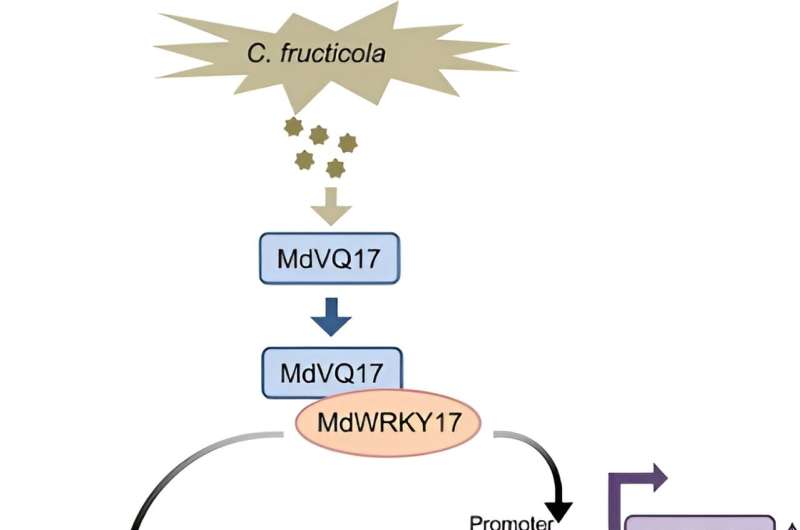This article has been reviewed according to Science X's editorial process and policies. Editors have highlighted the following attributes while ensuring the content's credibility:
fact-checked
peer-reviewed publication
proofread
The apple's battle plan: Unraveling the molecular response to fungal infections

Apple cultivation is widespread, but Glomerella leaf spot (GLS), caused by the fungus Colletotrichum fructicola, poses a major threat, especially in China. This disease damages leaves and fruits, reducing yield and quality.
Currently, GLS is primarily managed with fungicides, which have environmental drawbacks. To address these challenges, it is essential to deepen our understanding of the molecular mechanisms that drive apple susceptibility to GLS, particularly the impact of genes like MdVQ17.
The research, conducted by Northwest A & F University and published in Horticulture Research on June 7, 2024, explores how MdVQ17 regulates apple susceptibility to GLS. The study identifies MdVQ17 as a significant modulator that increases disease susceptibility by enhancing salicylic acid degradation and pectin lyase activity.
The study demonstrates that MdVQ17 weakens apple resistance to GLS by interacting with the transcription factor MdWRKY17. This interaction boosts MdWRKY17's activation of key genes such as MdDMR6 and MdPL-like, which are involved in salicylic acid degradation and pectin lyase activity, leading to increased vulnerability to GLS.
The results highlight a complex regulatory network that diminishes the plant's defense and alters critical biochemical pathways, presenting new targets for breeding GLS-resistant apples.
"Understanding the interactions between MdVQ17 and MdWRKY17 provides valuable insights into the genetic factors contributing to apple disease susceptibility. This study not only identifies key regulatory components but also offers potential pathways for developing more resilient apple cultivars," says Dr. Ke Mao, a senior researcher in the study.
These insights could shape future breeding strategies targeting the MdVQ17-MdWRKY17 complex to enhance apple resistance to GLS. By suppressing MdVQ17 expression or disrupting its interaction with MdWRKY17, it may be possible to develop apple varieties that are less dependent on chemical fungicides, promoting more sustainable apple production.
More information: Dingyue Duan et al, MdVQ17 negatively regulates apple resistance to Glomerella leaf spot by promoting MdWRKY17-mediated salicylic acid degradation and pectin lyase activity, Horticulture Research (2024). DOI: 10.1093/hr/uhae159
Journal information: Horticulture Research
Provided by Northwest A & F University




















